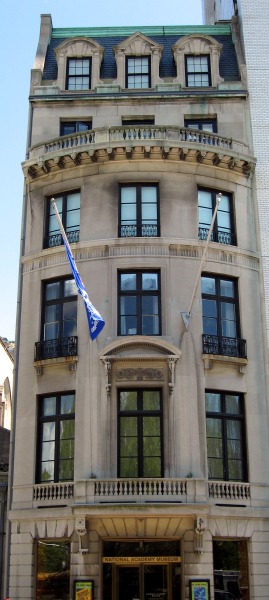Next time you’re playing Scrabble and want to wow opponents with a game-changing word, try this one: deaccessioning.
That's when a museum sells off objects from its collection, and it’s a big no-no in the art world when museums do it to cover operating costs. In 2008, the Upper East Side's National Academy Museum got into big trouble for selling off two Hudson River School paintings for $13.5 million and using the money to shore up the museum’s troubled finances. The Association of Art Museums Directors (A.A.M.D.), a national group, responded with tough sanctions. But on Monday, the A.A.M.D. announced those sanctions were suspended after the National Academy Museum demonstrated that it had learned its lesson, and pledged never again to sell its works.
"Our goal was in no way to punish the institution," says Kaywin Feldman, the A.A.M.D.'s president. "It was really to set the example of what our founding principles are, and the way in which we expect art museums to behave."
 The sanctions imposed on the National Academy Museum barred the A.A.M.D.’s 198-member museums from collaborating with the it, which meant no lending or borrowing art—an essential part of exhibit curation for many. According to Feldman, the museum found the sanctions extremely "onerous." On October 4, the association’s board unanimously voted to stop the sanctions, and place the museum on a five-year probation, during which time its conduct will be monitored.
The sanctions imposed on the National Academy Museum barred the A.A.M.D.’s 198-member museums from collaborating with the it, which meant no lending or borrowing art—an essential part of exhibit curation for many. According to Feldman, the museum found the sanctions extremely "onerous." On October 4, the association’s board unanimously voted to stop the sanctions, and place the museum on a five-year probation, during which time its conduct will be monitored.
"I was almost a little dismayed about how far it went," says Lee Rosenbaum, who blogs on the arts as CultureGrrl at ArtsJournal.com. "To my mind, telling other museums that they can't associate in any way with their colleagues at the National Academy, this ostracism...was almost an assault on academic freedom. It went very far, and I'm glad to see that things have settled down."
This week's Academy Museum story is the latest in a spate of deaccessioning controversies that includes the New York Public Library's 2005 sale of a Durand painting to a Wal-Mart heiress for $35 million, and Fisk University's decision to sell pieces from its Stieglitz collection.
Museums are allowed to sell art in order to buy additional works and improve their collections, but according to the A.A.M.D.’s rules, which are regarded as a generally accepted ethical code among museum directors, they can’t treat artworks as assets that can be liquidated to cover operating costs.
However, as WNYC reported in August, several major museums, including the Museum of Modern Art and the Guggenheim, opposed a proposed new law in Albany that would prevent museums from deaccessioning to cover operating costs. And in September, the New York State Education Department's Board of Regents, which oversees museums, allowed emergency regulations on deaccessioning to expire. For now, there are no legal guidelines in New York about the practice, leaving the policing to the A.A.M.D.
WNYC asked a range of experts what they thought about the Academy Museum case and museum deaccessioning.
 Kaywin Feldman - President of the Association of Art Museum Directors and director of the Minneapolis Institute of the Arts:
Kaywin Feldman - President of the Association of Art Museum Directors and director of the Minneapolis Institute of the Arts:
"It's certainly common that museums deaccession artwork in their collections for a very specific set of reasons—to eliminate a duplicate in the collection, or because the work of art is beyond the possibility of conservation, or a whole variety of reasons. But we have very strict guidelines that say that any sums gained by the sale of artwork need to be reinvested in the collections. So, from the A.A.M.D. standpoint, collections are not fungible assets.
"While museums do deaccession, it's absolutely extremely rare to deaccession for operating funds, and something that our organization does not condone in any sense. So, it is actually very, very rare that we would put sanctions on another institution. It's a very core principal that we conserve those works of art in trust for our community. So, it's absolutely something that we all share."
 Sergio Muñoz Sarmiento - Associate Director, Volunteer Lawyers for the Arts and blogger for the arts law blog Clancco and the Deaccessioning Blog:
Sergio Muñoz Sarmiento - Associate Director, Volunteer Lawyers for the Arts and blogger for the arts law blog Clancco and the Deaccessioning Blog:
"It's amazing, it's surprising really how many arts organizations are struggling. And many of them have artworks that they've never exhibited, they don't plan to exhibit, that they don't make available to the public. If what we're saying is that we'd much rather have an institution close its doors so long as it maintains its collection intact, then I have to question the rationale behind that gesture. What good is that going to do for the community in general?
"I don't invest art with that sacredness that I think some of the anti-deaccessionists do. And I think that many times, the public, especially those that talk bout the 'public trust,' they don't have to sit with employees that will tell you, 'Look, I'm going to be laid off.' And it's not until you see the true realities of their income, their family situation, that it starts to hit you: this goes beyond what we like to think of as 'Art with a capital 'A.'"
 Lee Rosenbaum - Blogs as CultureGrrl at ArtsJournal.com, and originally broke the Academy Museum deaccessioning story in 2008:
Lee Rosenbaum - Blogs as CultureGrrl at ArtsJournal.com, and originally broke the Academy Museum deaccessioning story in 2008:
"The usual rule is not to sell museum quality works that are in the museum, that belong in the museum, and should stay in the museum. It's of more concern than ever now because so many museums are having financial strain, and it's very tempting to monetize art in order to pay the bills. I think that museum quality works are the public's patrimony and they should be safeguarded by the institutions that are entrusted to do so.
"Nobody who's not regulated wants to be regulated. It's a natural reflex reaction to say, 'We're doing fine the way we are, we don't need the government to oversee us.' Various institutions have shown that self-policing is not working all that well, and I still think that we do need very clear guidelines not coming just from the field itself, but from the government on this issue. There have been too many instances of breaches of the kinds of ethics that should be following in deaccessioning.
"So, yeah, the landscape is a little murky right now, but hopefully there will be more discussion and some workable guidelines can be reached."